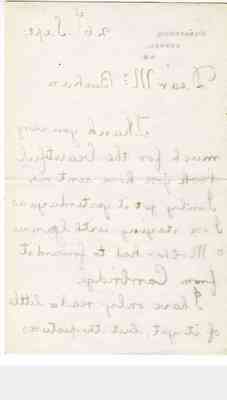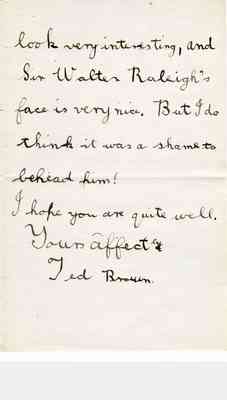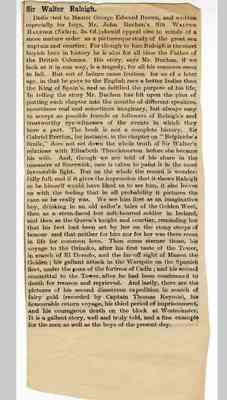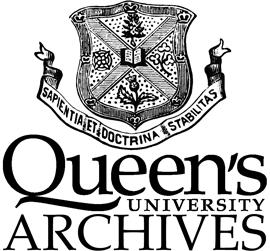Pages
page_0001
KILMARONAIG, CONNEL, N.B.
26th Sept [1911]
Dear Mr. Buchan Thank you very much for the beautiful book you have sent me I only got it yesterday, as I am staying with Grannie & Mother had to forward it from Carrbridge. I have only read a little of it yet, but the pictures
page_0004
Sir Walter Raleigh
Dedicated to Master George Edward Brown, and written especially for boys, Mr. John Buchan's SIR WALTER RALEIGH (Nelson, 3s. 6d.) should appeal also to minds of a more mature order as a picturesque study of the great sea captain and courtier. For though to him Raleigh is the most boyish hero in history he is also for all time the Father of the British Colonies. His story, says Mr. Buchan, if we look at it in one way, is a tragedy, for all his ventures seem to fail. But out of failure came fruition for us of a later age, in that he gave to the English race a better Indies than the King of Spain's, and so fulfilled the purpose of his life. In telling the story Mr. Buchan has hit upon the plan of putting each chapter into the mouths of different speakers, sometimes real and sometimes imaginary, but always easy to accept as possible friends or followers of Raleigh's and trustworthy eye-witnesses of the events in which they bore a part. The book is not a complete history. Sir Gabriel Bretton, for instance, in the chapter on "Belphoebe's Smile," does not set down the whole truth of Sir Walter's relations with Elizabeth Throckmorton before she became his wife. And, though we are told of his share in the massacre at Smerwick, care is taken to paint it in the most favourable light. But on the whole the record is wonderfully full; and if it gives the impression that it shows Raleigh as he himself would have liked us to see him, it also leaves us with the feeling that in all probability it pictures the man as he really was. We see him first as an imaginative boy, drinking in an old sailor's tales of the Golden West, then as a stern-faced but soft-hearted soldier in Ireland, and then as the Queen's knight and courtier, reminding her that his feet had been set by her on the stony steeps of honour and that neither for him nor for her was there room in life for common love. Then come sterner times, his voyage to the Orinoko, after his first taste of the Tower, in search of El Dorado, and the far-off sight of Manoa the Golden ; his gallant attack in the Warspite on the Spanish fleet, under the guns of the fortress of Cadiz ; and his second committal to the Tower, after he had been condemned to death for treason and reprieved. And lastly, there are the pictures of his second disastrous expedition in search of fairy gold (recorded by Captain Thomas Keymis), his honourable return voyage, his third period of imprisonment, and his courageous death on the block at Westminster. It is a gallant story, well and truly told, and a fine example for the men as well as the boys of the present day.






